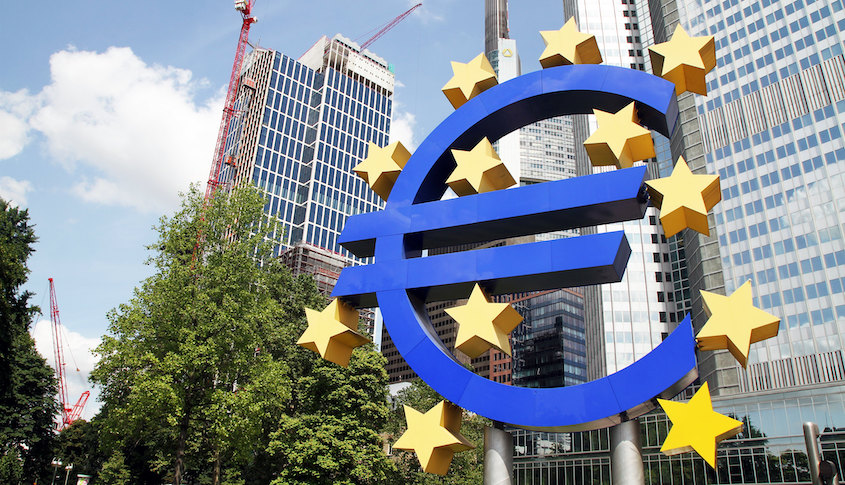
Alex Guibord via flickr
A Digital Euro and Central Bank Digital Currencies

Jörn Quitzau
Bergos AG
Joern Quitzau is a Geoeconomics Non-Resident Senior Fellow at AGI. He is Chief Economist at Bergos, a private bank based in Switzerland. He specializes in economic trend research and economic policy. Joern Quitzau hosts two Economics podcasts.
Prior to his position at Bergos, Joern Quitzau worked for Berenberg in Hamburg (2007-2024) and Deutsche Bank Research in Frankfurt (2000-2006) with a special focus on tax and fiscal policy.
Dr. Quitzau (PhD, University of Hamburg) was a Visiting Fellow at AGI in April 2014 and September 2022 and an American-German Situation Room Fellow in April 2018.
Cryptocurrencies continued to make headlines in 2020 and early 2021. For one thing, Bitcoin rallied again in November, December, and the beginning of January, lifting its price to more than $40,000 – well above its previous record high of around $20,000 in December 2017. Before that, however, a topic that had previously only been discussed in expert circles grabbed the public’s attention: digital central bank currencies.
The European Central Bank published its “Report on a Digital Euro” in the autumn of 2020. With this publication, the ECB officially joined a debate that had previously been conducted by the Swedish, Chinese, and Swiss central banks. Sweden and China had already launched pilot projects and pursued them aggressively, so their preparations have reached an advanced stage. By contrast, the Swiss National Bank has been content to act behind the scenes. Other countries are also considering the possibility of digital central bank currencies. And now the ECB too is officially weighing the pros and cons of an “E-Euro”.
What to make of such electronic currency variants? Already, a significant portion of payments is conducted not with cash, but electronically—at least in countries with advanced financial systems. Electronic payment options, including not only instant and mobile payments, but also online payment services, have proliferated even more in the past few years. So the question becomes: what is novel about the E-Euro and what niche is it supposed to occupy? The answer is simple: The primary purpose of digital central bank money would be to serve as a counterpart to cash in countries with well developed payment systems.
The primary purpose of digital central bank money would be to serve as a counterpart to cash in countries with well developed payment systems.
A digital Euro could perform the same functions as cash or even supplant cash in the long term. Cash is still popular among people in Germany and some other countries, even though the proportion of cash payments has fallen of late, not least due to the coronavirus pandemic. Replacing cash with an E-Euro would provoke considerable resistance in society. As a precaution, the ECB clarified that it has no intention of doing away with cash, but only to introduce an E-Euro as a complement to cash. It remains to be seen if a digital central bank currency would encounter any significant demand at all under these circumstances. On the one hand, those who do not wish to pay with cash already have a plethora of non-cash payment options to choose from. A digital Euro would simply be one more option, which would most likely be used by tech-savvy people. On the other hand, those who prefer to pay with cash have their reasons for this preference and would hardly be persuaded to stop using cash by the availability of a digital central bank currency.
For these reasons, the ECB is probably not motivated by an acute need or demand for an E-Euro. Instead, it is looking to the future and cites various reasons in its report as to why a digital Euro could be advantageous in the future. Such reasons include possibly growing demand for electronic payment options, noticeably declining cash usage, the issuance of digital central bank currencies by other central banks, and the competition posed by private cryptocurrencies (like Bitcoin or the planned Facebook currency Libra, which is apparently now to be called Diem). The latter scenario could endanger financial stability and violate basic consumer protection interests.
Seen in this light, the ECB’s initiative to study the possibilities of an E-Euro and discuss them with different stakeholders is not only legitimate, but indeed also urgently necessary if the ECB does not want to become irrelevant in a digital world. The ECB itself has stressed the point that it is only studying the possibility of issuing a digital Euro and has made no final decision.
The elimination of cash at some point in the future would be politically controversial.
The uncertainties are considerable. Opportunities and risks cannot yet be properly assessed. Digital central bank money could deprive commercial banks of sight deposits if financial intermediaries are no longer needed. The choice between cash and sight deposits could be rendered moot if the two are deemed to be virtually equivalent. Digital central bank money could also put pressure on the business models of private payment services providers. Finally, there is the question of what will happen with the data and information generated in connection with payment transactions. Besides the issues related to data security and data protection, there is a distinct possibility that private enterprises will be cut off from valuable information and data they could otherwise commercially exploit.
The elimination of cash at some point in the future would be politically controversial. If that happens, central banks would be able to enhance the efficacy of their interest rate policy by imposing negative interest rates. Today, savers can avoid negative interest rates to some extent by withdrawing money from their accounts and holding it in the form of cash. However, this option would vanish in a world with only digital central bank currency, although a “flight” to other asset classes would still be possible, and negative interest rates would erode the value of savings. For this reason alone, the demand for digital central bank money would probably be limited if it were introduced as an alternative to existing cash rather than as a replacement for it.









